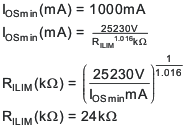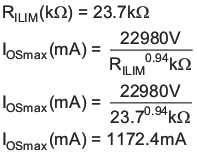SLVSBD0B November 2012 – June 2020 TPS2553-Q1
PRODUCTION DATA.
- 1 Features
- 2 Applications
- 3 Description
- 4 Revision History
- 5 Pin Configuration and Functions
- 6 Specifications
- 7 Parameter Measurement Information
- 8 Detailed Description
-
9 Application and Implementation
- 9.1 Application Information
- 9.2 Typical Applications
- 10Power Supply Recommendations
- 11Layout
- 12Device and Documentation Support
- 13Mechanical, Packaging, and Orderable Information
Package Options
Refer to the PDF data sheet for device specific package drawings
Mechanical Data (Package|Pins)
- DBV|6
Thermal pad, mechanical data (Package|Pins)
Orderable Information
9.2.1.2 Detailed Design Procedure
For this example, assume that 1 A must be delivered to the load so that the minimum desired current-limit threshold is 1000 mA. Use the IOS equations and Figure 22 to select RILIM.
Equation 2. 

Select the closest 1% resistor less than the calculated value: RILIM = 23.7 kΩ. This sets the minimum current-limit threshold at 1 A . Use the IOS equations, Figure 22, and the previously calculated value for RILIM to calculate the maximum resulting current-limit threshold.
Equation 3. 

The resulting maximum current-limit threshold is 1172.4 mA with a 23.7 kΩ resistor.